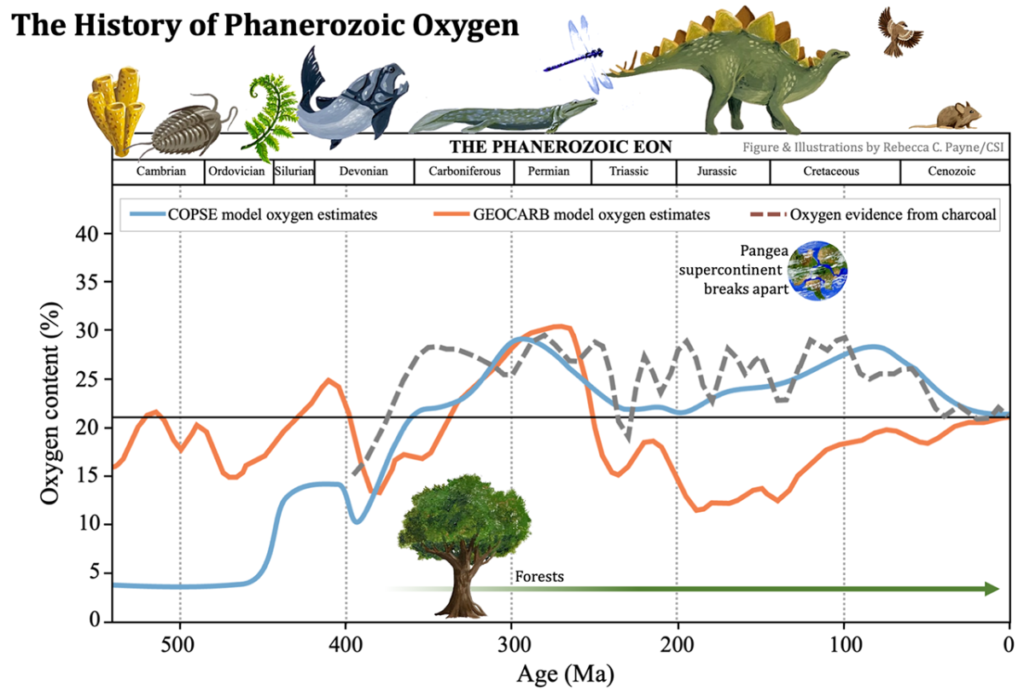A recent study, led by Rebecca Payne and Lisa Kaltenegger of the Carl Sagan Institute, suggests that space telescopes could more easily detect exoplanet “Jurassic Worlds” with higher levels of atmospheric oxygen akin to Earth’s atmosphere during the Phanerozoic Eon, a long period in Earth’s geologic history in which dinosaurs and other animals and plants had their origins.
These hypothetical Jurassic worlds, where giant alien beasts could roam around alongside strange and massive flora, may be easier to spot due to the increased number of biomarkers that would likely be present.
On Earth, this ancient period saw atmospheric oxygen levels fluctuate between 10% and 35%, significantly higher than today’s 21%. These elevated oxygen levels, alongside methane, would have produced more robust biosignature pairs in the light fingerprints of Earth, allowing distant non-human observers to note some typical atmospheric signs of life. The same logic stands today for humans glaring at distant exoplanets.
The search for exoplanets is a journey of exploration driven by the human quest to understand our place in the cosmos. Lisa Kaltenegger, director of the Carl Sagan Institute (CSI) and one of the study’s authors, told the Cornell Chronicle that “modern Earth’s light fingerprint has been our template for identifying potentially habitable planets, but there was a time when this fingerprint was even more pronounced – better at showing signs of life. This gives us hope that it might be just a little bit easier to find signs of life – even large, complex life – elsewhere in the cosmos.”
Biomarkers, such as oxygen, play a critical role in this quest. They serve as indicators of potential life, as evidenced by our planet, where oxygen is a byproduct of photosynthesis. Detecting these biomarkers in the atmospheres of exoplanets could signal the presence of life as we understand it on Earth. Telescopes like the James Webb have already begun pinging exoplanets, collecting telemetry and data on their atmospheric conditions.


Although biomarkers like oxygen do not guarantee life, as they can be produced abiotically, a planet with an oxygen-rich atmosphere is considered a strong candidate for hosting life forms. Understanding the formation and evolution of Earth’s oxygen-rich atmosphere provides crucial insights for applying oxygen as a biosignature in our extraterrestrial search. Yet, scientists remain cautious, as oxygen can sometimes be a false positive for life’s presence on distant worlds.
This all begs a big question that will get any Jurassic Park fan excited: why dinosaurs?
This latest study posits a compelling theory: exoplanets with atmospheric compositions similar to Earth’s past could be among the best targets for finding complex life in the universe. As Kaltenegger suggests, such planets would have light fingerprints that stand out more distinctly than those of the modern Earth, potentially easing the daunting task of detecting extraterrestrial life.
Using data from two climate models (GEOCARB and COPSE), the team simulated Earth’s atmospheric composition and resulting transmission spectra over five 100-million-year increments of the Phanerozoic. These lengthy eras featured large-scale changes to Earth’s ecosystems. The ocean’s biosphere became more complex, giving rise to a diverse collection of life. Forests and jungles flourished. A surge in diverse animal life, including dinosaurs, roamed the Earth. To paraphrase Jeff Goldblum as Dr. Malcolm in Jurassic Park (1993), “life found a way.”
All these changes influenced the rise of oxygen and other gasses in our atmosphere.
“It’s only the most recent 12% or so of Earth’s history, but it encompasses pretty much all of the time in which life was more complex than sponges,” said study co-author Rebecca Payne. “These light fingerprints are what you’d search for elsewhere, if you were looking for something more advanced than a single-celled organism.”
Alien worlds will develop in alien ways and won’t necessarily mimic how life formed on Earth. Still, Payne and Kaltenegger say their models fill in a missing puzzle piece of what a Phanerozoic Eon planet would look like to a telescope, providing a clearer picture for exoplanets high in atmospheric oxygen. From the microbial to the megafauna that once roamed our world, the diversity of life that thrived in the high-oxygen epochs of Earth’s history suggests that if similar conditions exist on exoplanets, they too could harbor a rich tapestry of organisms.
The possibility that somewhere in the vastness of space, there may be worlds teeming with life, perhaps even “other dinosaurs,” not only enriches our understanding of the universe but also renews our sense of wonder and exploration. It beckons us to look up and outward, to continue the search for those distant, yet strangely familiar, Jurassic worlds.
MJ Banias is a journalist and podcaster who covers security and technology. He is the host of The Debrief Weekly Report and Cloak & Dagger | An OSINT Podcast. You can email MJ at mj@thedebrief.org or follow him on Twitter @mjbanias.

